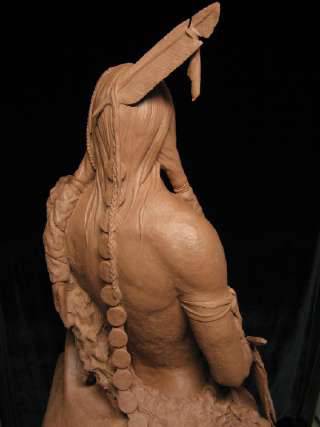Leadership of San Marcos prepares monument to honor Chief Placido
By Maria R. Gonzalez
University News Service
March 30, 2007
The San Marcos community will soon have a new addition to the historical markers and monuments that honor the heroes of the past, a statue that will honor the contribution of the forgotten founders of San Marcos—the Tonkawa.
The Leadership of San Marcos Class of 2007 will dedicate a statue of Chief Placido, leader of the Tonkawa tribe, in November. The bronze statue will be mounted on a pink granite base and placed in a prominent spot at the city park adjacent to the San Marcos River.
The Tonkawa lived in what is now San Marcos prior to the arrival of white settlers in the 1840s. Chief Placido and his Tonkawa warriors were valuable allies to the white settlers and fought together in battles during the Texas-Mexico war and against their common adversary, the Comanche. In the Battle of Plum Creek, fought near what is now Lockhart, the Tonkawa warriors ran alongside the militia for thirty miles and returned mounted on the horses of fallen Comanche warriors.
 Chief Placido clay study (rear view) |
Chief Placido and the Tonkawa helped the settlers establish San Marcos, a piece of history that has been relegated to brief descriptions in historical accounts of Central Texas history. Monuments to Chief Placido’s close friends and allies General Burleson, Sam Houston, Jack C. Hays and Stephen F. Austin abound in Central Texas but nothing pays tribute to the Tonkawa contribution. This is what lead Leadership of San Marcos member Rodney van Oudekerke to embark on a quest to honor the Tonkawa.
“One of the requirements to become a member of the Leadership of San Marcos is to identify a community need and to act on that need,” he said. “I presented the idea of a monument or tribute to the Tonkawa people and Placido. I believe that if you are going to tell history, you have to tell all of it.”
There are approximately 500 Tonkawa in Oklahoma and Leadership of San Marcos is working with them to create a statue that is emblematic of the tribe. If finding accounts on the Tonkawa in history books is difficult, finding an accurate photograph of Chief Placido was nearly impossible. Eric Slocombe, local artist and sculptor, had the challenging task of creating the statue using early 20th century photographs of Tonkawa women and men.
“These photographs were taken during the early 1900s. I put together a little bit of everything including facial features and clothing. It’s nice that I’ve had at least names and faces and these are actual people,” he said. “I am trying to blend the history of the Tonkawa tribe and throwing the artistic bit of it so we have a piece of art that people will enjoy looking at. It has been a tough balance trying to get it all to work out.”
The statue honoring Chief Placido is the first step toward the dissemination of the Tonkawa’s role in Texas history and in the establishment of San Marcos. Van Oudekerke said that Leadership of San Marcos hopes the statue will spark dialogue in the community and at Texas State University.
“I want people in San Marcos and Texas to realize that the dedication of the statue in November is only the beginning. We want people to start talking about Chief Placido and the Tonkawas and their contribution,” he said. “We hope the university can use this to spark an exhibit about the history behind the statue.”
For more information, contact the Leadership of San Marcos at (512) 353-0800 or visit them online at www.leadershipsanmarcos.com.